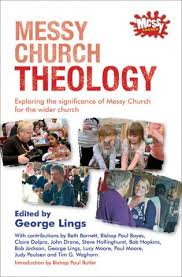 Messy Church Theology is a collection of essays reflecting on different aspects of Messy Church, from its role in mission, 'to church or not to church' and inclusivity amongst others. The second chapter written by Steve Hollinghurst is titled, 'When is Messy Church not church?' which together with the first chapter by Claire Dalpra discerning when it is church, wrestle with an interesting challenge. Messy Church can be a fresh expression of church, OR an outreach OR even a new expression of worship for an existing church community. Having established that all can exist appropriately in different contexts, Hollinghurst makes a valid point which anyone involved in missonal projects may do well to heed. He writes, 'When fresh expressions of Church start with worship [as opposed to starting with living and spending time in the culture, building community and discerning what worship may look like in that culture], it is likely that the worship will be what Christians think is an appropriate expression in that culture, when, as yet, they know far too little to be sure that is true.' This warning is not solely aimed at those engaging in Messy Church, but to any who are thinking of starting a missional 'something' to reach an area or group. We are perhaps in danger of projecting our own styles and expressions onto projects which, if given more time, may have develop their own characteristics and flavours that reflect the culture of the group being reached in the first place. He goes on to remind us though of the impact that being in a worshiping and believing community can have. Being plunged into an innately Christian culture of worship can in itself be a missional experience. Somewhere a balance needs to be struck to allow different groups of people, or geographical areas to find an expression of worship that is their own, and not prescribed by a pre-existing church, but at the same time, be given a chance to experience an authentic worshiping community, something that will only be achieved if already practising Christians, hence with a pre-existing style create for them to experience. An interesting dichotomy. Well worth a read.
0 Comments
Sunday 28th July. 1730 hours. 27 families. 50+children under 10. 1 Dining Hall. 1 Factory. 6 Days. Family Camp.
The Family Camp at YWAM Harpenden over the last week was great! Lots of hard work, but lots of smiles, action songs, creativity, cuddles, silliness and some really profound lessons. Having worked for a church, and YWAM and volunteered with lots of different organisations, I have learnt that each place has its own language. When I hear 'Family' used in the church, I often think of the meaning as 'something for everyone, provision for each member of the family' - i.e. maybe a bit together, but mostly in respective age groups. Perhaps it's a language thing, but often in YWAM, 'family' means 'all-age' or 'intergenerational'. Something I have become used to - although I still didn't know what to expect at our family camp. However, I was challenged and delighted to see a culture being set at this camp of families doing things together - the fun, the serious and the spiritual. It was great to see the 'all-age' bits really being 'all-age' and not just children-focused. To cut a long story (or week) very short, daily we had 'Tribal Gatherings' (or all-age worship/creative sessions) morning and evening. The morning one was followed by the daily 1.5hrs in age groups, followed by lunch. After lunch each day there were creative options: bubbles (epic bubbles at that, sculpture, high-rope tree climbing, water-fun, wide games, drama workshops, learning the Bible off by heart and so on. Most of those were to give the opportunities for whole families to have fun together. Then there was the evening Tribal Gathering, followed by tea, and then something for the older children and adults once the kids were in bed. Despite running the 4-7's program, which was so much fun and filled with some delightful manners and wide-eyed wonders, the thing that struck me were the Tribal Gatherings. Although chaotic and noisy, they were filled with heart-felt worship, dramas to challenge and to relate to, symbolic activities of handing on batons and 'bag time' to talk about the day. One on-going activity was that each family had a large planter, and each day added something to their garden. The gardens represented their family and the family's spiritual life, and it was great to see them pulling up weeds and stones and talking about the hard things or things that need to be removed from family life; the hedge of protection around the garden and the role of parents, the planting of seeds - again the role of parents in choosing what to invest in their children and the watering - seeking God for nourishment. All the families I spoke to felt God had spoken to them about some aspect of their family life - particularly from a spiritual perspective, and were hoping to put some of the ideas and values in place. I too went away excited at the prospect of being more inclusive and feeding the age-relevant stuff into the bigger picture - a value I've owned for a long time, but haven't seen put into practice so explicitly before. Click the link below to read a great blog post about why, and whether we should be thinking again about our space and how it looks and feels. All the time I was reading it, I was thinking about children, young people and their families... What are we doing to provide an amazing, fun and comfortable place for them to come together - during our services AND otherwise....
CLICK HERE TO READ THE BLOG BY ONE BEAT.... 'FEELS LIKE HOME' |
AuthorMy musings. Opinions my own, and potentially not that thought through! Archives
October 2020
Categories
All
|

 RSS Feed
RSS Feed
